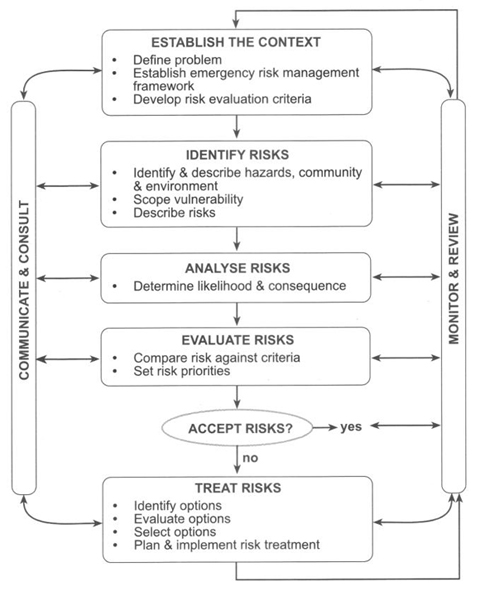What is the link between hazard analysis, risk analysis and emergency risk management?
Earlier we examined hazard, hazard analysis, risk, risk analysis and vulnerability. Let us now look at emergency risk management, in order that we can identify the link between them.
In 1995 the Australian New Zealand Standard on Risk Management (AS/ NZS 4360) was developed and published. The standard provides a generic process for developing and implementing risk management programs within organisations. The Standard defines risk management as "the culture, processes and structures that are directed towards realizing potential opportunities whilst managing adverse effects" (Standards Australia/ Standards New Zealand, 2004). The standard was designed so as to be adaptable for use within any enterprise and was the first national standard of its type in the world dealing with risk management.
The standard provides a five-stage process for risk management. The individual stages are:
|
This stage requires the overall context of the risk management program to be established, including establishment of the specific strategic, organizational, internal, external and risk management contexts of the program. It also requires the development of criteria to evaluate the risks and the definition of the program's structure.
|
|
This stage requires the identification of all risks that need to be managed using a structured systematic process. The aim is to generate a comprehensive list of events, their causes and scenarios that might affect elements of the organisation.
|
|
This stage analyses each risk identified previously and separates the minor acceptable risks from the major risks. The analysis involves identification of the sources of risk, the consequences of the risk and the likelihood that those consequences will occur, from which we can determine the level of risk.
|
|
This stage involves the comparison of levels of risk found during the risk analysis with the previously established risk evaluation criteria (during the establishment of the program contexts). This stage also involves the formation of a prioritised list of risks for further action.
|
|
The final stage of the process involves the identification of a range of options to treat each risk. Each option is assessed and plans are developed and implemented to treat the risks. |
An expanded diagram of the risk management process as described in the AS/NZS 4360:2004 Risk Management Standard is shown in Figure 1.1.
Since its publication, many enterprises, both government and non-government, in Australia and overseas, have used or adapted the AS/ NZS 4360 Risk Management standard to enhance their own risk management programs.
In the late 1990s, the Australian emergency management community, under the coordination of Emergency Management Australia, used the standard to develop a set of guidelines for implementing the risk management standard in an emergency management context - Emergency Risk Management. This Emergency Risk Management Application Guide defines emergency risk management as "a systematic process that produces a range of measures that contribute to the wellbeing of communities and the environment" (EMA, 2000). These guidelines have provided another 'tool' for emergency managers to complement existing hazard analysis, risk management, emergency management and general management planning processes. A copy of these guidelines (Emergency Management Australia, (2000), Emergency Risk Management - Applications Guide) are provided within the Course resource CD that you obtained when you commenced the course. These guidelines are also available online by visiting the Emergency Management Australia web site at http://www.ema.gov.au and following the 'Publications' link.

Figure 1.1
Emergency Risk Management Process
Source: Emergency Management Australia, 2000, Emergency risk management applications guide, EMA: Canberra.
So what is the linkage between the hazard analysis process and risk analysis? If you read the sections relating to the identification, analysis, evaluation and treatment of risks in the Emergency Risk Management Applications Guide (EMA, 2000) you will see that the identification and analysis of hazards are key components within stages of the emergency risk management process. Rather than being a stand alone process, the hazard analysis process is an integral and important part of the emergency risk management process.
The basic Emergency Risk Management (ERM) risk assessment process is provided in Topic 2, Figure 2.3 whereas the expanded risk management process from the AS/NZS4360:2004 is shown in Figure 1.1. You will notice that the two diagrams are very similar, however there are subtle additions to the ERM risk management process, noticeably the inclusion of hazard identification and description and community and environmental descriptions. Both of these processes provide the emergency manager with a comprehensive 'box of emergency management planning tools' that can be used to improve the emergency management strategies and arrangements within our communities.